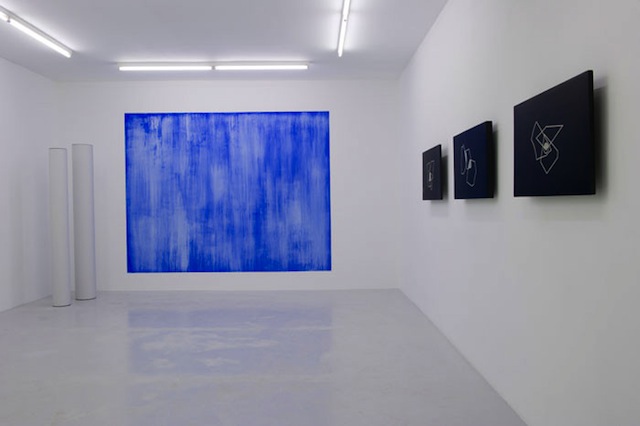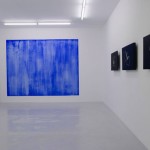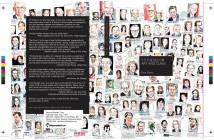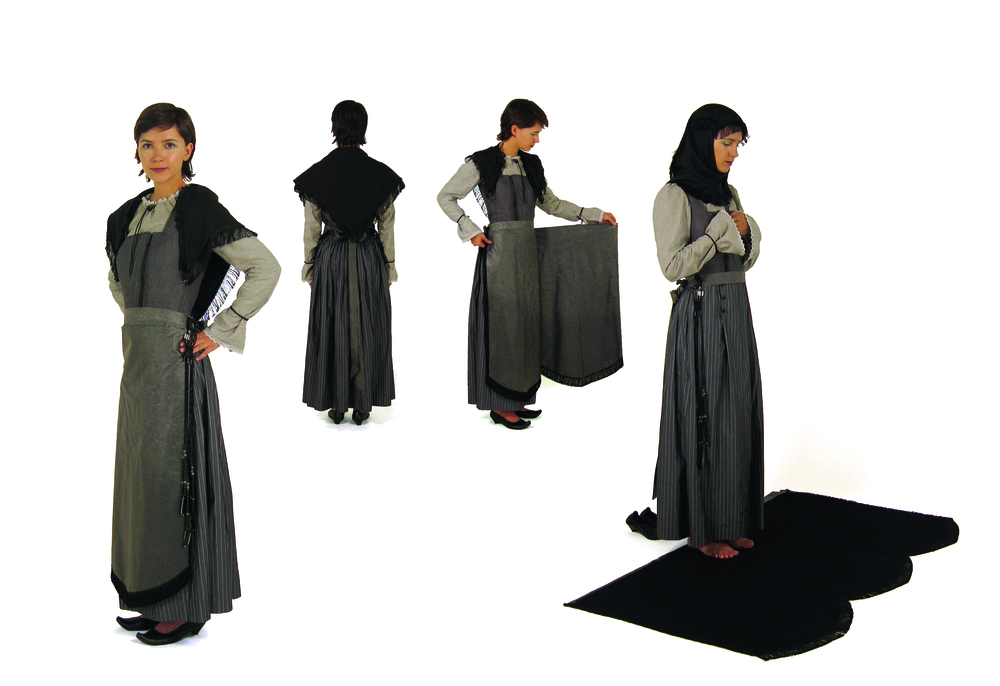Adriana Lara, a conceptual artist working in New York and Mexico City, makes work that seems both demanded by and wonderfully indicative of a new type of epistemology of digital exchange. But this can be stated of many younger artists emerging today. The more instructive question might be how Lara navigates issues of the subject that have lead to our post-internet moment. Over the past several years her subjects are wide ranging, though her formal strategies revolve around placement of syntactical elements, the visualization of quantitative relations, and text.
The recent framework for Lara is notable. Her inclusion in the New Museum’s 2009 Triennial The Generational: Younger Than Jesus aligned her recent practice with the general manner of viewing, constructing, and proactively mining the work of younger artists along lines of computational aptitude. The development is itself a side effect of the curatorial turn towards the logic of a sort of net utopia, where truths are located by finding the correct links or navigating the coded worlds of an ascendant regime of digital natives.
For the New Museum Lara instructed a museum guard to eat a banana each morning and discard the peel somewhere in the museum’s galleries. It was not in any way referencing digital technology, yet the timing was significant. Guests encountered a randomly placed banana throughout the museum just as the discourse around networked aesthetics and exchange seemed to advance upon the territory of the hard-won battles of identity politics and relational aesthetics. Banana Peel was also mediated within a labor relationship; that Lara’s work implicated the largely working class museum personnel was a further development of Fred Wilson’s comment on the invisibility of museum guards, Guarded View (1991). But it might have been the last gasp of an institutional critique that would be aimed at its physical inhabitants.

On any given day the banana may have landed near Ryan Trecartin’s Siblings Topics (Section A) (2009), and for a moment a historically reliant, staged institutional gesture rubbed up against a new media artist adventuring into the preferred medium of his work’s ahistorical tween subject. In retrospect, what emerged from the 2009 Generational was an anxiety that operated in digital motion—to borrow part of a concept from David Joselit. Trecartin’s pronouncements about the commercialism and the networked self may have established a momentary geist. But Lara’s work since 2009 deviates from this moment—itself undefined—carrying themes of language and desire that have become a companion to a recent strain of the aesthetics of network anxiety.
Lara has been described as Post-Conceptual. Like her forbearers she has formed an agency-like organization to facilitate creative production, albeit with a post-Fordist spin of a global corporation of knowledge workers. Lara is co-founder of Mexican artist collective Perros Negros, a group that "that proposes new platforms for discourse and production, for the purpose of expanding creative projects and giving them visibility."
PERROS NEGROS is a production office of artistic projects in small, medium and big scale, carried out from a research of possibilities and collaborations between different agents; not necessarily related to each other; it is a platform that gathers the effort of artist and promoters as well as institutions, brands and foundations. Being its main aim the stimulation of the contemporary creation. Perros Negros concentrates its efforts on binding (linking) the local with the global production and vice versa; giving a new meaning to certain cultural values.
That Perros Negros describes itself in terms that are linked to an international business, complete with offices, research, platforms, and agents may be a reflection of a generation’s disregard for capitalist signifiers in an age of the benevolent corporation; or it could be a critical reflex of post-NAFTA Mexico and its destabilized labor force. Perros Negros produces the free online magazine Pazmaker, of which Lara is Editor-in-Chief. Pazmaker is available for download for free from the group’s website, who’s design is purposely amateur as a comment on the laissez-faire ideology behind the open data movement and the pirate nether region of the web.
Broadly, the sources for Lara’s installations and paintings are text, but more specifically illegibility and code. NY — USA, a recent exhibition of her work at Algus Greenspon, is introduced by Mixed Media (2012), an oversize text on the gallery wall written in an obscure Malian dialect. It was the text from a press release for a completely separate exhibition, yet it was rendered useless by its illegibility. Adjacent was a C-print photograph of pages from Artforum magazine folded into an origami-like shape. Of the Malian text, we were told that the "number of people that speak this language is tiny and their interests, presumably, far removed from those of the artwork’s audience," which quite incidentally might also describe much of the content ofArtforum. Instead the language is exhibited as pure form, a fact no doubt underscored by its use of the cheeky comic sans font. Lara shifted the viewers across two vehicles of illegibility, creating pure form from two distinct sources of obscure manifestations of language systems. An editor herself, Lara asks us how inscrutability structures the power relationships in aesthetic discourse.
Encryption and desire were the general themes at work in many of the 20 some pieces in NY — USA, which ranged from silk screens on plastic, oil block prints, and inkjet on linen. Lara’s Symbol Faces were diaphanous silk screens superimposed typographic symbols on noir-ish images of a Mexican actress popular in the 1930s. The lyrical nature of the actress is confounded by the programmatic of the symbols. The works all contained the same set of characters ("&", "!", "$", "#", and "@"). By only lightly altering their configurations, Lara suggests how a similar message can be scripted (or encrypted) in various combinations.

In a world ever more mediated by digital exchange, it is difficult to ignore the interpretation of these ambiguities as related to string expressions or data types. Depending on the programming language employed, "&", "!", "$", "#", and "@" will have different meanings. In the same manner, the arbitrary symbols Lara uses on her female subject provide varying context depending on their relationship to the underlying image. The subject becomes the very contrasts throughout the series, an affect made more dramatic by the translucent plastic that sometimes revealed their wooden supports. Geometric swatches of color punctuate this series; in one particularly bare instance, the only human form offered is a silhouette of red lips. The experimental comingling of symbols embeds our desire with the underlying image the actress.
Lara has considered textual ambiguity before. In S.S.O.R (Symbolic Surface of Revolution), a recent exhibition at Kunsthalle Basel, Lara exhibited the looped digital video installation 2012 (2012), whose title presents information both as a string of text and a date format; at once a redundant formulation of a signifier (the title) and signified (the date). This relies on the relational structures of such typographic characters for disambiguation, a technology that empowers the now ubiquitous rapid exchange of messages and data. By employing text, symbols, and their varying formats, Lara is dealing with distinctions that are fundamental to both semiotics and information technology, perhaps bridging the seminal ideologies of the twentieth and twenty-first centuries. Likewise, 1 (one) from Numbers (Disambiguation) (2012) a six foot high cylinder wrapped in canvas that was exhibited at both at S.S.O.R and at Air de Paris as part of a group show, was a totem to the secret grammar of numbers. In the middle of a gallery at Kunsthalle Basel laid her Living Sculpture (2012), a mess of A4 printer paper on the gallery floor imprinted with the typographic pattern that recurred throughout the silkscreens in NY — USA. Symbolic Surface of Revolution (S.S.O.R) is a reference to a mathematical theory related to curves. The world "Revolution" also smuggles the prospect of Utopia among what now seems like a lapsed promise of technocracy and political progress.

Lara’s Smoking Kills series (exhibited in NY — USA in 2013) are several inkjet on linen reproductions of cigarette packages. Mainstream and obscure brands alike, the renderings are near exact copies of the originals’ box design. In some details, the ink has the slightest trouble settling into the linen, revealing a crucial difference in surface from the shiny packages. The carefully selected color palettes and the mythical narratives that each brand retells seem like an affront to our capacity to reason. Again Lara deals with the semiotics of desire. The brands’ use of words like "filter", "natural", and "mild" become starkly apparent as they relate to a delicate system of language, used to both mask and elicit identity.
Through the encounter with the typographic characters and cigarette packages, the reception of Lara’s Symbol Faces and Smoking Kills relate to the post-conceptual and neo-surrealist style associated with commonplace objects. Yet Lara draws a clear line away from neat, industrial fabrication. This is what a knowledge worker looks like when put in a factory—the products are not manufactured as much as they are retouched and repositioned for new consumptions. Nadezhda Tolokonnikova, imprisoned member of Pussy Riot, recently wrote of modern capitalism in a letter to Slajov Žižek:
Everything is geared towards gripping the emotion of the consumer. Modern capitalism seeks to assure us that it operates according to the principles of free creativity, endless development and diversity. It glosses over its other side in order to hide the reality that millions of people are enslaved by an all-powerful and fantastically stable norm of production.
What does Lara do differently with the now ubiquitous mode of re-staging the common consumer object? How does she shift this mode of production of the anxious object? The Smoking Kills series, or her use of the checkered photoshop canvas in 1 (one) from Numbers (Disambiguation), or the stark environments created by the artists in a problem has occurred at Air de Paris begin to articulate how digital exchange has begun to uncover the hidden reality that Nadezhda described to Žižek. At least, they formally seem to support Michael Sanchez’s theory that many recent paintings have achieved "relaxation that counters the anxiety fed by the speed of the scroll interface." Specifically, it Lara’s neon chroma key Scryyns painted directly on the wall of Air De Paris in 2012 that are proponents of software-mediated exchange that Sanchez deems a sort of "screen povera," "coldly rustic surfaces" whose texture functions as a "respite from information."
One of her earliest solo shows was a problem has occurred at Air de Paris. The sparse, coded installation is flippant in its free play of materials. Lara’s inclusion of a framed Morandi print is a reference to the inauthenticity of screen viewing. As it’s hung here earnestly, it is surrounded by a mechanical aesthetic of grids and strings. "A Problem Has Occured" is a common retort of software programs, whose laconic persona uses the passive voice to mask intent. There are many problems to consider here. Most relevant to our tenuous position is that it reminds us that art was one of the first to interpolate the subject in these problems through an immersive experience that we, as users of software, now find commonplace.
Artists who render visible commonplace things have historically confronted their audience with ennui about the illusion of painting or craft. Today foreclosed aspirations of painting have collapsed into a network aesthetic tendered by a screen. Lara’s objects and symbols comment on systems of language and their encryption of desire. They also address a network anxiety as evidenced both by her editorial and starkly formal works that pull in quantitative themes. Since 2009 she has been an instructive proxy for how the power of post-conceptual practices are coming against the loose boundary marked out by the swirling discourse regarding post-internet practice. If Lara offers a negotiation, it is slippery; her intense focus on an almost semiotic encryption of meaning—as both stylistic device and as content—emerge from what cannot help but be viewed as an anxiety about corporatization and deeply pluralized promise of a de-politicized screen gaze.
- Installation view of Adriana Lara, Scryyns and Interesting Theories, 27 January to 3 March, 2012, at Air de Paris





